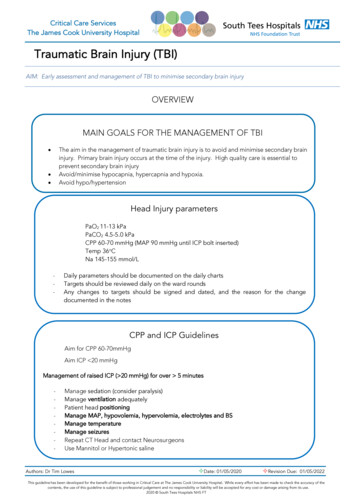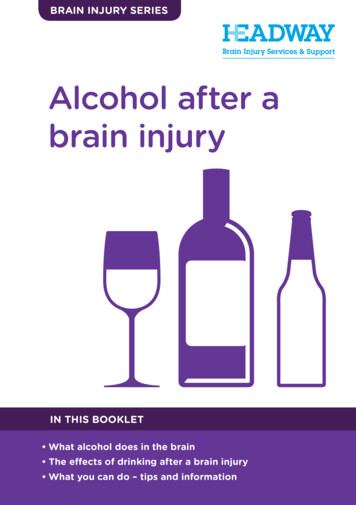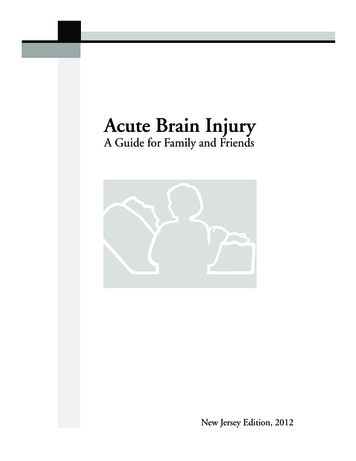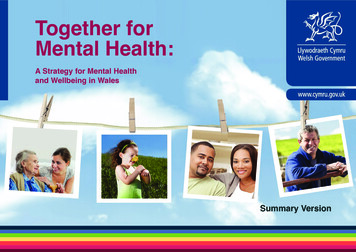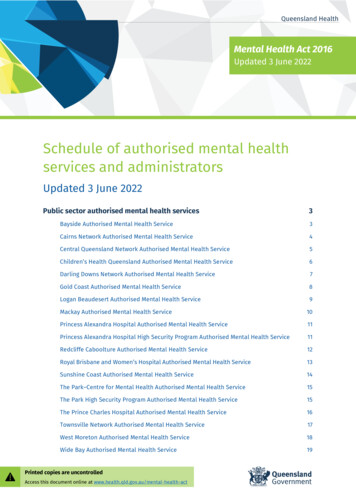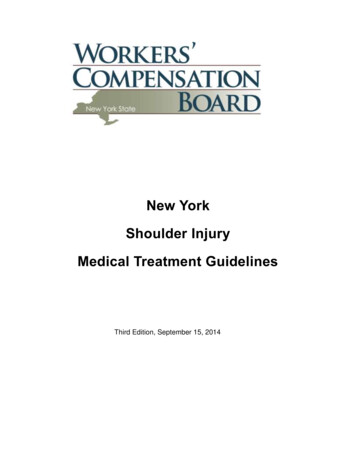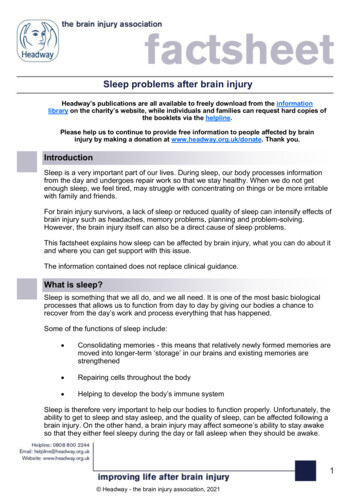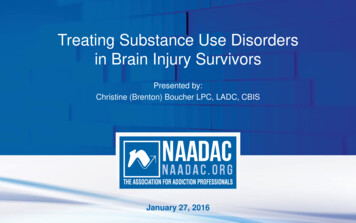
Transcription
MENTAL INJURYTREATMENTGUIDELINESVersion: 1Released: November, 2020
BACKGROUNDWorkCover Queensland monitors trends in the treatment and use of item codes through analysisof state-wide data. This helps us to ensure injured workers receive optimal quality of care andtheir return to work outcomes are maximised, in addition to maintaining a financially viablescheme that balances costs for employers.These guidelines are designed to be a roadmap for visibility and transparency when treatingworkers with a work-related mental injury.Medical interventions relating to mental injuries have been included in the guidelines. WorkCoveremployees will use these guidelines when approving requests for medical interventions relatingto work-related mental injuries. It is important to note that these are general guidelines to assistwith treatment and management of work-related mental injuries and there may be exceptions orextenuating circumstances relating to treatment requests. Should a provider seek an exception tothe guidelines, it is recommended that they contact the Customer Advisor to discuss the request.Further expert medical opinion may be sought by WorkCover to assist with approving therequested intervention.Conditions detailed in the explanatory notes of the Medicare Benefits Schedule (MBS) also applyto the medical items schedule of fees, with some noted exceptions. The schedule is available atworksafe.qld.gov.au.Where an intervention is identified for a second opinion, WorkCover employees will seek theassistance of the Medical and Allied Health Panel (MAHP) or an Independent Medical Examiner(IME) prior to approving the intervention. WorkCover will share with you the information receivedfrom a MAHP or IME for your information, review and comment.It is important to note that some therapies currently have emerging evidence supporting theirefficacy and the current Association and College position is to research and explore these further.These treatment modalities will be reviewed and monitored regularly. These guidelines will beupdated in line with the evidence based research supporting the relevant treatment modality.These guidelines will also be used for post payment data analysis to identify ongoing paymenttrends and issues.WorkCover acknowledges the expertise and contribution of all stakeholders, particularlymembers of Royal Australian and New Zealand College of Psychiatrists (RANCZP) and theAustralian Psychological Society (APS), that provided comment for the review of the mentalinjury guidelines.MENTAL INJURY GUIDELINES
WORKCOVER MODELWorkCover is committed to ensuring workers receive optimal quality care delivered in a timely manner,which supports a return to work outcome, whilst acknowledging the challenges of the compensationsetting.It is important to note that WorkCover can only cover work-related mental injuries. These injuriescould span Adjustment Disorders, Major Depressive Episodes, Anxiety Disorders and Post TraumaticStress Disorders (PTSD) arising from work related events.1WorkCover endorse and apply the Biopsychosocial and Lifestyle Model (BPSL) to the management andtreatment of psychological and psychiatric injuries arising from work related events.The BPSL Model provides a useful framework for understanding the factors that contribute todevelopment of mood disorders and for planning clinical management. It encompasses biological,psychological and social perspective alongside lifestyle factors and is referred to as the BPSL Model.Typically, mood disorders arise from factors from more than one domain. Consequently, a broad rangeof treatments are usually needed to satisfactorily treat mood disorders, anxiety disorders and licSocialLifestyleReactiveBiological TreatmentsPsychological TreatmentsSocial TreatmentsAntidepressantsAntipsychoticsMood stabilisersElectroconvulsive therapyTranscranial magneticstimulationBrief cognitive behaviouraltherapyFormal cognitive behaviouraltherapyInterpersonal therapyMindfulnessAcceptance & commitmenttherapySchema therapyExposure therapyFamily psychoeducationFamily / friendsFormal support groupsCommunity groupsCaregiversEmployment (inc graduatedreturn to work)HousingLifestyle TreatmentsExerciseDietSmoking cessationAlcohol cessationCeasing drugsManaging substance misuseSleep[1] Adapted from Malhi, Gin & Bassett, Darryl & Boyce, Philip & Bryant, Richard & Fitzgerald, Paul & Fritz, Kristina & Hopwood, Malcolm &Lyndon, Bill & Mulder, Roger & Murray, Greg & Porter, Richard & Singh, Ajeet. (2015). Royal Australian and New Zealand College of Psychiatristsclinical practice guidelines for mood disorders. Australian & New Zealand Journal of Psychiatry. 49. 1087-1206. 10.1177/0004867415617657.
WORKCOVER RETURN TO WORK PHILOSOPHYThe Royal Australasian College of Physicians Position Statement on realising the health benefits ofwork highlights that being off work for long periods of time can significantly reduce the likelihood of aworker ever returning to work.In addition to the RACP Position Statement, best practice frameworks from both Superfriend andSafeWork Australia support a biopsychosocial approach to treatment and rehabilitation, and earlyintervention to improve recover at work/return to work outcomes. For injured workers, as the time forthem off work increases, the chance of return decreases.75% chance of returning to work50% chance of returning to work25% chance of returning to work0% chance of returning to work20 days off work45 days off work70 days off workA workers social and economic wellbeing, including wherever possible recovery at work, or return towork, should be a central outcome of best practice. We all have a responsibility to:understand the health benefits of good work and of early intervention;have a commitment to collaboration; &take an evidence-based approach to ensuring the best outcomes.If worker can stay at work after an injury, or get back to work gradually while they recover, they're morelikely to recover quicker and be able to get on with their life.Staying connected to their workplace, even if their work tasks are adjusted, means they can maintain adaily routine and get back some control and independence. This helps with their physical recovery aswell as supporting their mental health and general state of mind.
APPROVED TREATMENT I N T E R V E N T I O N SApplicable fees and item codes are outlined in the WorkCover Medical Table of Costs.WorkCover only support and fund evidence-based treatment interventions. In determining this, WorkCover refers to the relevant practiceguidelines of the applicable Associations. Experimental treatments are generally not approved within the WorkCover scheme.Medical interventionCognitive BehaviouralTherapy(CBT)DescriptorCognitive Behaviour Therapy (CBT) is a relatively short term,focused approach to the treatment of many types of emotional,behavioural and psychiatric problems. The application of CBTvaries according to the problem being addressed, but is essentiallya collaborative and individualised program that helps individualsto identify unhelpful thoughts and behaviours and learn or relearnhealthier skills and habits.Each session should be accompanied with ‘out of session’ tasks, tohelp achieve real changes and consolidate any shifts in thinking.Mindful based strategies and exercise physiology services can bebeneficial as a value add to the CBT treatment.Delivery ModeOutpatientApprovalApproved by WorkCover as perTable of Costs.NOTE: Prior approval of service isrequired.Average treatment course 10-12sessions (framework as perMedicare Scheme). Sessionscommence weekly for the 1st 4weeks and then fortnightly forthe remainder.Usually takes 6-8 weeks(estimated) to see improvement.Maximum treatment approval is16 sessions.
Trauma Focussed CBT(TF-CBT)This treatment is a phased and component-based treatment. Thethree phases of TF-CBT are: Stabilisation; Trauma narration and processing; and Integration and consolidation.Like EMDR, it is exposing the worker to the event (imaginal). There isalso an ‘in vivo’ (biological) component to this treatment.WorkCover will consider on a case by case basis (with theappropriate specific justification) support for the worker with an ‘outof office’ erapy is a modality of treatment in which the psychiatristand patient(s) work together to relieve psychopathologicalconditions and functional impairment through focus on:§§§the therapeutic relationshipthe patient’s attitudes, thoughts, affect, and behaviour andthe social context and development.Useful for assisting with interpersonal difficulties at work or home,that is impacting on the worker’s capacity to return to normalfunctioning.Outpatient.Approved in WorkCover fortrauma related incidents as perTable of Costs.May be deliveredinpatient as part ofa privateNOTE: Prior approval of service ispsychiatricrequired.hospital admissionand program.Average treatment course 12-16sessions, but it is important tonote response time is variable.OutpatientTreatment should be given as pera structured plan.NOTE: Prior approval of service isrequired.Maximum of 16 sessions.Delivery is usually more frequentat the start of course andbecomes less frequent (e.g.monthly) as the courseprogresses.
Acceptance andCommitment Therapy(ACT)ACT is a form of psychotherapy. It uses acceptance and mindfulnessstrategies mixed in different ways with commitment and behaviourchange strategies, to increase psychological flexibility.OutpatientNOTE: Prior approval of service isrequired.Recommended as an alternative form of CBT to enhance return towork for the following: chronic pain tinnitus mental illness work-related strain.Average treatment course 13-20sessions. Sessions commenceweekly for the 1st 4 weeks andthen fortnightly for theremainder if progress is beingmade.Generally, not recommended as a primary treatment for anxiety anddepression.Progressive MuscleRelaxation (PMR)This is used not for relaxation purpose per se. It is used more on aclinical level to ensure that clients have an awareness of the firstsigns of a stress response and can utilise their arousal reductionstrategies early rather than allowing the elevation increasing to alevel where it is difficult to control.Approved by WorkCover as perTable of Costs.Usually takes 6-8 weeks(estimated) to see improvement.OutpatientMaximum treatment approval is20 sessions.Approved by WorkCover as part ofthe CBT treatment regime(outlined above).NOTE: Prior approval of service isrequired.
Eye MovementDesensitization andReprocessing (EMDR)Eye Movement Desensitization and Reprocessing (EMDR) is apsychotherapy treatment originally designed to alleviate thedistress associated with traumatic memories.During EMDR therapy, the worker attends to emotionally disturbingmaterial in brief sequential doses while simultaneously focusing onan external stimuli.Eye movements are used during one part of the session. After theclinician has determined which memory to target first, they ask theworker to hold different aspects of that event or thought in mindand to use their eyes to track the clinician’s hand as it moves backand forth across the client’s field of vision.Outpatient.Approved in WorkCover fortrauma related incidents as perTable of Costs.May be deliveredinpatient as part ofa privateNOTE: Prior approval of servicepsychiatricis required.hospital admissionand program.Not approved for the treatmentof specific phobias, panicdisorder and agoraphobia.Generally, 12 sessionsmaximum, but it is important tonote response time is variable.EMDR therapy is an eight-phase treatment.Repetitive TranscranialMagnetic Stimulation(rTMS)WorkCover will consider on a case by case basis (with theappropriate specific justification) support for the worker with an ‘outof office’ session(s).rTMS is an effective and evidence-based treatment for depression.Outpatient.There is limited clinical study data to confirm the efficacy of rTMS inthe treatment of PTSD conditions.rTMS involves the focal application of a localised, pulsed magneticfield to the cerebral cortex, inducing small electrical currents whichstimulate nerve cells in the region of the brain involved in moodregulation and depression. Magnetic fields are passed through theskull to the brain using a coil placed on the patient’s head. Thetreatment is non-invasive and does not involve seizure induction orloss of consciousness. The patient is completely alert during theprocedure and an anaesthetic is not required.Approved by WorkCover fordepressive conditions only asper Table of Costs.NOTE: Prior approval of serviceis required.Not approved for PTSDtreatmentAverage treatment course 15-20sessions (3-4 weeks, delivereddaily Monday-Friday).
ElectroconvulsiveTreatment(ECT)Electroconvulsive therapy (ECT) is a therapeutic medical procedurefor severe and treatment resistant psychiatric disorders. Thismeans the disorder has failed to respond to a range of moreconventional and safer treatments.ECT is used only for the most profound cases of MelancholicDepression and often only where the depression is associated withsignificant neuro-vegetative disturbance, catatonia, or otherpsychotic features.It is not a long-term treatment and is generally provided as a courseof treatment (average of 8-12 sessions).Inpatient as part ofa privatepsychiatrichospital admissionand program.Approved by WorkCover as perTable of Costs.Final treatmentsonly may becompleted asoutpatient.Average treatment course 8-12sessions.NOTE: Prior approval of serviceis required.ECT treatments given 3 timesper week.
NON-APPROVED TREATMENT I N T E R V E N T I O N STreatment interventions that are not approved by WorkCoverExperimental treatments are not approved within the WorkCover scheme. As stated previously, WorkCover only support and fund evidence-based treatmentinterventions. In determining this, WorkCover refers to the relevant practice guidelines of the applicable Associations and the appropriate testing levels asdetermined by the NHMRC.Treatments that are not approved by WorkCover are outlined in the table below:Medical interventionDescriptorDeep Brain Stimulation (DBS)DBS is used only as a treatment of last resort in extremely debilitating conditions. It has an uncertainevidence base for both efficacy and side effects. It is regarded as an experimental treatment.Mild Brain Stimulation (MBS)See Deep Brain Stimulation (DBS) above.Dialectical Behaviour Therapy (DBT)Dialectical Behaviour Therapy (DBT) is a modified version of cognitive-behavioural therapy (DBT) designed toprimarily treat Borderline Personality Disorder (BPD). BPD is a disorder which arises due to geneticpredisposition and often in combination with early childhood traumatic experiences. DBT is rarely, if ever,used for the treatment of other conditions. Borderline Personality Disorder cannot arise as a result of aworkplace issue.Transcranial Direct Current Stimulation(tDCS)tDCS has an uncertain evidence base for both efficacy and side effects. It is regarded as an experimentaltreatment.Schema therapySchema therapy is a newer type of therapy which combines elements of CBT, psychoanalysis, attachmenttheory and emotion-focussed therapy.Psychodynamic therapyPsychodynamic therapy is the psychological interpretation of mental and emotional processes.Equine Therapy (Eagala)Equine-assisted psychotherapy incorporates horses into the therapeutic process. Workers engage in activitiessuch as grooming, feeding and leading a horse while being supervised by a mental health professional.Medicinal Cannabis (e.g. CBD oil)Most medicinal cannabis products are currently unregistered medicines and access to these products isthrough the Commonwealth Special Access or Authorised Prescriber Scheme.More research is being done on the uses of medicinal cannabis - the current scientific evidence basesupporting its efficacy and outcomes is limited.
PHARMACOTHERAPYWorkCover approve the relevant pharmacotherapy for the treatment and management of workrelated mental injuries, where an evidence-based practice supports its use and efficacy.It is noted there is a wide variety of psychotropic medication which are often used in combination,prescribed by treating practitioners. WorkCover expects that psychotropic medications areprescribed in accordance with conventional practices, particularly regarding maximum doses andcombinations of medications.Common treatment practices involve starting with SSRI or SNRI medications, gradually titratingup doses, before either switching to an alternative agent or using agents in combination, as per thetable below.Reference: https://www.ranzcp.org/files/resources/college statements/clinician/cpg/mood-disorders-cpg.aspxIt is recognised that benzodiazepines can become medications of dependence and they should beprescribed carefully, for short periods of time. The risk of dependency should be openly discussedwith the patient. This is in line with the recommendation from the Australasian Chapter ofAddiction Medicine.Practitioners seeking further information or guidance are recommended to reference ProfessorStahl’s Essential Psychopharmacology Prescriber’s Guide (6th edition).MENTAL INJURY TREATMENT GUIDELINES
PRIVATE HOSPITAL ADMISSIONSWorkCover will not fund the following private hospital admission requests requests unless there iscompelling evidence outlining and supporting the need for admission:for the initiation of psychiatric medications; orto switch psychiatric medications; orto wean down psychiatric medications.Further, all private hospital admissions require prior approval from WorkCover before the admission.TREATMENTIt is critical for the optimal management of work-related psychological and psychiatric injuries that thetreating Psychiatrist/Psychologist provide WorkCover a clear and detailed description of the treatmentprograms including timeframes, patient centric goals and expected outcomes.COMPLEMENTARY THERAPIESWorkCover only supports and funds evidence based treatment interventions and therefore do notapprove the use of complementary therapies.GENERALWorkCover will only approve medical interventions that are undertaken to treat changes caused by thework-related injury or event (WRI).Where a claim has been accepted as an aggravation of a pre-existing medical condition, WorkCover mustconsider whether the proposed medical intervention is to treat changes caused by a work-related injury orevent or pre-existing changes. If the medical intervention is to treat pre-existing changes WorkCover will notbe able to cover the intervention.Early diagnosis and timely requests for appropriate psychological/psychiatric interventions are critical.During the decision-making process for approval of psychological/psychiatric interventions, WorkCover will:consider available medical information from treating practitionersreview the Mental Injury Guidelinesconsider the worker's past medical history and determine if further information is requiredif further information is required, request clarification from treating practitioner regarding the rationalefor proposed intervention and relationship of request to accepted WRI,if a second opinion is warranted, seek independent medical opinion (IME/MAHP)if contrary independent opinion is obtained, discuss further with treating practitionerconsider the weight of all medical information and evidence provided to make decisionensure decision is communicated to treating practitioner and the worker.DEFINITIONSAggravation: A factor which may or may not be work-related that has causedworsening of pre-existing changes of a permanent nature.Exacerbation: A factor which may or may not be work-related that has caused atemporary worsening of a pre-existing medical condition.Recurrence: A recurrence requires no identifiable incident as trigger to resumptionof symptoms or signs related to the pre-existing medical condition.New Injury: An identifiable new incident must be shown to have caused the injury.Disability: A decrease in, or the loss or absence of, the capacity of an individual tomeet personal, social or occupational demands.
REFERENCESIt is important to note that the Reference List below is not an exhaustive list of resources reviewed, but is ademonstration of the breadth of evidence-based research utilised in the development of these ience.org/ACT Randomized Controlled nt/psychodynamic CShttps://www.odgbymcg.com/treatment/schema ess g/files/resources/college sources/college les/resources/college statements/clinical s/college statements/clinical e w.ranzcp.org/files/resources/college statements/clinical .wiley.com/doi/full/10.1002/wps.20626.
This helps us to ensure injured workers receive optimal quality of care and their return to work outcomes are maximised, in addition to maintaining a financially viable scheme that balances costs for employers. These guidelines are designed to be a roadmap for visibility and transparency when treating workers with a work-related mental injury.

